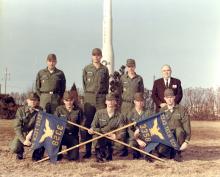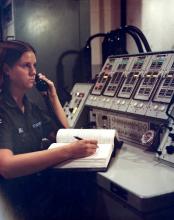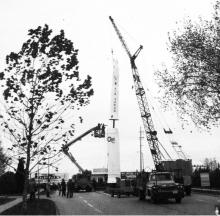 In the summer of 1776, the Second Continental Congress of the thirteen colonies met in Philadelphia and drafted a document that declared independence from British rule to the world. Following this Declaration of Independence, the new nation quickly prepared for war and named George Washington as commander of the continental army. Still, even before Washington's appointment, local militias formed to protect their communities from British attacks. Within these local militias, small groups were developed to answer the call to arms in emergencies. These minutemen, who were named as such because they were ready in a minute's notice, were a protective force that eased the concerns of continental towns and cities and became symbolic of American protection from aggressive forces.
In the summer of 1776, the Second Continental Congress of the thirteen colonies met in Philadelphia and drafted a document that declared independence from British rule to the world. Following this Declaration of Independence, the new nation quickly prepared for war and named George Washington as commander of the continental army. Still, even before Washington's appointment, local militias formed to protect their communities from British attacks. Within these local militias, small groups were developed to answer the call to arms in emergencies. These minutemen, who were named as such because they were ready in a minute's notice, were a protective force that eased the concerns of continental towns and cities and became symbolic of American protection from aggressive forces.
 Nearly two centuries later, in the mid-1950s and early 1960s, the U.S. government developed an intercontinental ballistic missile named the Minuteman I as part of the arms race with the Soviet Union. Like the Minutemen of the Revolutionary era, this weapon was made to protect U.S. citizens in a minute's notice from would-be aggressors.
Nearly two centuries later, in the mid-1950s and early 1960s, the U.S. government developed an intercontinental ballistic missile named the Minuteman I as part of the arms race with the Soviet Union. Like the Minutemen of the Revolutionary era, this weapon was made to protect U.S. citizens in a minute's notice from would-be aggressors.
The Minuteman I missile was made by Boeing and stands at approximately 55 feet tall with a weight of roughly 65,000 lbs. In combat, the missile offered a range of about 5,500 miles with an accuracy of 1.5 miles. The Minuteman I was followed in development by the Minuteman II missile, and finally, the Minuteman III, which is the only land-based intercontinental ballistic missile still in service today.
 As the Minuteman I was developed for combat, the U.S. military needed the right place to train technicians on handling, maintaining, and using the weapon. In 1959, Chanute Air Force Base was selected as the site for Minuteman I training. By the time the Minuteman I was operational on December 11, 1962, Chanute-trained personnel were already at missile sites performing their duties across the country. The Base offered 33 courses on the Minuteman and produced skilled technicians at a rate of 3,000 per year.
As the Minuteman I was developed for combat, the U.S. military needed the right place to train technicians on handling, maintaining, and using the weapon. In 1959, Chanute Air Force Base was selected as the site for Minuteman I training. By the time the Minuteman I was operational on December 11, 1962, Chanute-trained personnel were already at missile sites performing their duties across the country. The Base offered 33 courses on the Minuteman and produced skilled technicians at a rate of 3,000 per year.
 The Minuteman I missile located at the west entrance to the former Chanute Air Force Base is one of the last symbols of the Base left in Rantoul. The details of its arrival in 1966 are unclear. Perhaps it was used for training or was just brought in for display. Regardless, like the minutemen of yore, this missile became symbolic of protection for the Rantoul community and those who called Chanute their home.
The Minuteman I missile located at the west entrance to the former Chanute Air Force Base is one of the last symbols of the Base left in Rantoul. The details of its arrival in 1966 are unclear. Perhaps it was used for training or was just brought in for display. Regardless, like the minutemen of yore, this missile became symbolic of protection for the Rantoul community and those who called Chanute their home.
Although this Chanute monument was slated for removal on September 14, 2020, the outcry from the local community and beyond has saved this piece of Air Force history.
- Tom Kuipers
Archives Assistant
--
In 2016, The Urbana Free Library acquired over 800 cubic feet of archival materials from Chanute Air Force Base, Chanute Technical Training Center, and the Octave Chanute Aerospace Museum. If you are interested in learning more about the Base and its history, please view our digital Chanute exhibit available at urbanafree.omeka.net. For further information about the former Base, please visit the Champaign County Historical Archives and ask about our Chanute collection.
